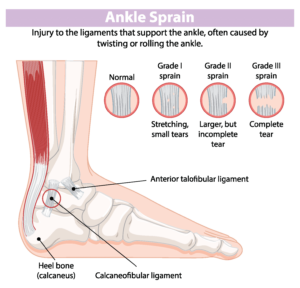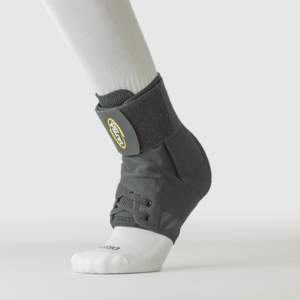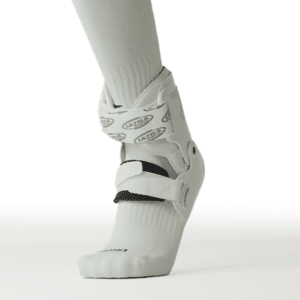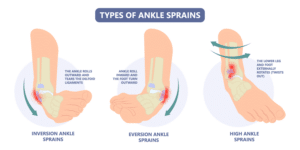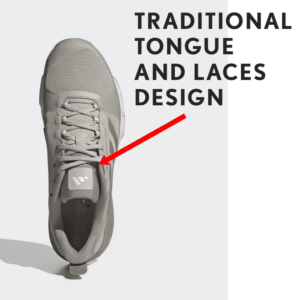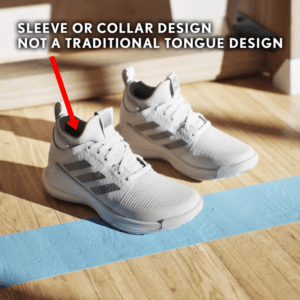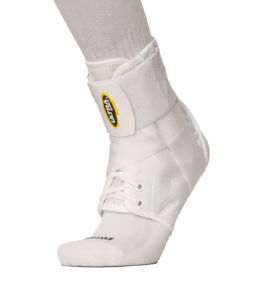Introduction
With teenage basketball players each year it gets more intense and aggressive and to compete you must match that level of intensity. Training becomes more important to keep yourself in the best physical condition. However, sometimes your body’s ligaments, tendons, and bones cannot handle the increased intensity and aggressiveness which leads to sports injuries. And although one or two previous ankle injuries seemed like no big deal, now your ankle is turning more frequently and with more severity. We call this the Cycle of Injury which can only be slowed down or stopped wearing a professional ankle brace.
The ankle is the #1 injury in basketball primarily from stepping on another player’s foot and turning your ankle inward called an inversion ankle sprain. How many previous ankle injuries have you had? Are any of those ankle injuries the more severe grade 2 or 3? This blog will help you determine if you need to wear an ankle brace, what type of ankle brace you need, and the best basketball shoes to wear with ankle braces.
What happens if you don’t address lingering ankle issues? You will eventually have to quit the sport you love due to pain associated with chronic ankle instability which ultimately leads to ankle osteoarthritis when you are older. The good news is you can stop that cycle of ankle injuries now and continue to play the sport you love.
Had Any of These Basketball Ankle Injuries?
✅ Landing on Another Player’s Foot
✅ Quick Direction Changes
✅ High Impact from Jumping and Landing
✅ Growing Bodies and Developing Strength
Because of these risks, wearing ankle braces is one of the best ways to prevent injuries and keep teenage basketball players active and healthy.
How Do Ankle Braces Help Prevent Injuries?
Ankle braces are one of the most effective tools for preventing injuries and providing extra stability for teenage basketball players. They act as a protective layer, reducing the risk of sprains and allowing athletes to play with confidence.
Here’s how ankle braces help keep players safe on the court:
✅ Limits Excessive Ankle Movement that Causes Ankle Injuries.
✅ Provides Consistent Ankle Stability
✅ Reduces the Severity of Sprains Meaning Shorter Recovery Time
✅ Increases Confidence in your Ankle
Since basketball places constant stress on the ankles, wearing a brace is a simple and effective way to prevent unnecessary injuries and keep players on the court, rather than on the bench.
Braces vs. Taping: What’s the Better Option?
When it comes to ankle support, some players and coaches debate whether taping or wearing ankle braces is the better option. While both methods offer some level of protection, ankle braces provide more reliable, long-term support, making them the preferred choice for teenage basketball players.
Here’s why braces are the better option:
✅ Ankle Braces Provide More and Longer Lasting Ankle Support – Tape starts to loosen and lose effectiveness as the game progresses, while ankle braces provide constant stability from start to finish.
✅Ankle Braces are Easier to Use – Taping an ankle properly requires a coach or trainer and needs to be redone before every practice or game. Ankle braces, on the other hand, are easy to put on and take off without assistance.
✅ Ankle Braces are More Cost-Effective
Because of these advantages, most basketball players—from high school to the NBA—prefer ankle braces over taping for better, long-lasting support.
What to Look for When Choosing an Ankle Brace
Not all ankle braces are created equal, so choosing the right one is key to getting the best balance of support, comfort, and performance. Here are some important factors to consider when selecting an ankle brace for basketball:
✅ Level of Support Needed
- Mild to Moderate Support: Lace-up ankle braces (e.g., Ultra 360®) provide basic protection but can restrict movement.
- Very Good to Maximum Support: Hinged ankle braces (e.g., Ultra Zoom®) allow full range of motion while providing superior stability.
✅ Fit & Comfort
- Both lace-up and hinged ankle braces will fit comfortably inside basketball shoes given a proper break-in period.
- Lace-up ankle braces can be lower in profile or “not as bulky,” but they do not provide as much ankle stability as a hinged brace.
✅ The Right Basketball Shoes
- The best basketball shoes to wear with ankle braces are low top with a traditional tongue and laces where you can loosen the laces enough to fit the brace in the shoe.
- The worst basketball shoes to wear with ankle braces are mid-tops with a sleeve or collar design (no tongue) which limits the opening of the shoe making it very difficult to fit the brace in the shoe.
✅ Durability & Long-Term Use
- Lace-Up ankle braces are made with fabric so one sports season may be all you get before the product needs to be replaced.
- Our Ultra Zoom hinged ankle brace has a one-year warranty on every component. The straps and pads can be replaced as needed to make for a very durable and long lasting ankle brace.
By selecting the right ankle brace and pairing it with proper basketball shoes, teenage players can stay protected without compromising their comfort or performance.
Conclusion
For teenage basketball players, ankle injuries are a real risk, but they don’t have to be an inevitable part of the game. With the fast-paced nature of basketball—jumping, cutting, and landing—ankle sprains are one of the most common injuries. The best way to prevent them is by wearing a professional ankle brace.
Compared to taping, ankle braces provide better support, last longer, and are easier to use. Choosing the right brace depends on the level of protection needed—lace-up braces offer mild to moderate support, while hinged braces provide very good to maximum support without restricting natural movement.
To get the most out of an ankle brace, pair it with the right basketball shoes. Traditional tongue-and-lace shoes work best, while high-tops should be avoided since they don’t provide extra support and can create pressure points.
By investing in the right ankle brace, players can stay healthy, confident, and focused on improving their game—all while reducing the risk of injury.
